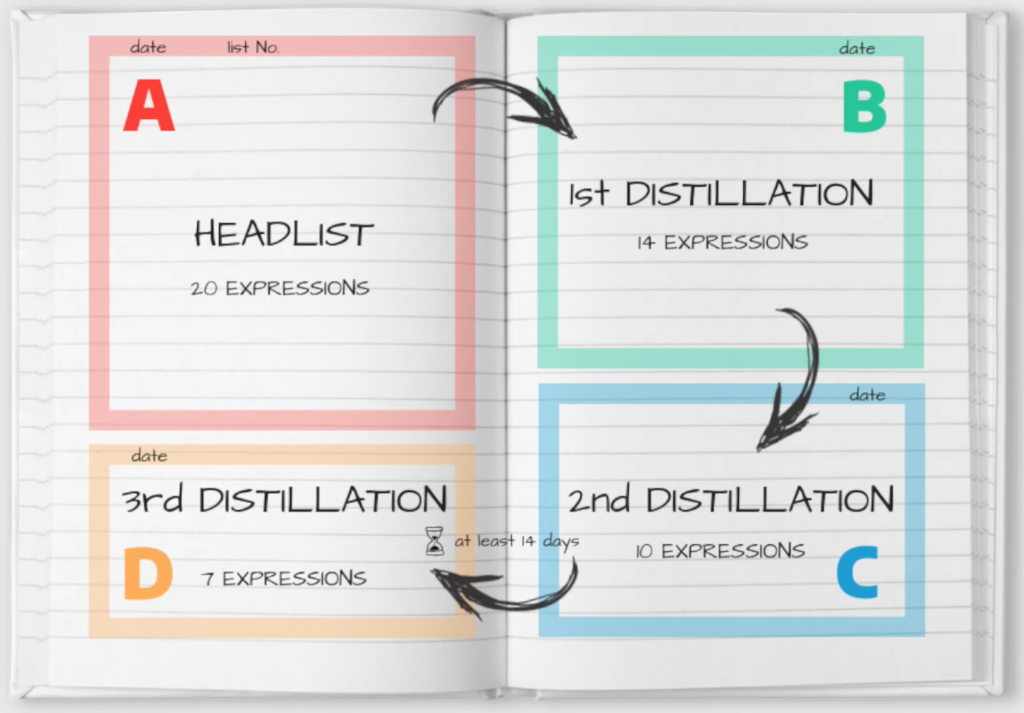The GoldList Method. Some love it. Some hate it. Some say there is no way it can work. Others, including polyglots swear by it. So what is it about the GoldList Method that works for language learning, and what might not be so efficient?
- Introduction
- What is the Goldlist Method of Polyglots?
- What is a Gold List?
- Key Features Of The Method
- What are the Key Principles Behind the GoldList Method?
- What Are the Benefits of the GoldList Method?
- Your Essential Tools: The Three-Column Notebooks
- GoldList Method Step-by-Step
- The ‘Science’ Behind Goldlist?
- GoldList Method, A Scientific Critique?
- Does the Goldlist Method Work? Success Stories
- Common Mistakes and How to Avoid Them
- In Summary: Mastering Vocabulary with the Goldlist Method
Introduction
To truly conquer a language, you must first grasp the vital role of building your vocabulary.
The more words you know, the better you can understand, express, and connect with others in different languages. Vocabulary is like the foundation of a house – you need it to build your language skills.

So how to most efficiently learn new vocabulary? This is the big question, especially for those of us with a long list of languages we want to learn. And seriously the most boring for me!
But what to do? Without memorising the words, it is impossible to learn the language… and yet, what a major SNOOZE!!

Even DuoLingo becomes boring after time… I kept it up for 3 months as I restarted learning French, but after they changed to the crowns system, all the beautiful golden circles that had kept me motivated disappeared *sad face*!
So I am always looking out for ways to shortcut the process.
Manually writing out flash cards… hmm no. I write about 20, never revise them, and waste those beautiful index cards for no reason.
Flash card apps… yeah, not too bad. But because I learn in such an eclectic fashion, word lists produced by others are either half already known, or not interesting themes.
And then we have this terribly inspiring comment from Michael of Renewing Truth…
An attainable goal is 25 words per week. If you’re really ambitious, go for 50 words a week. That’s 10 words per day with a weekend break for just review.

25 words per week, over a year is only 1250 words for the year – barely enough to give you an A1.1 grounding! And DEFINITELY not my definition of learning a language “fast”!
Enter… the GoldList Method! (*trumpets sounding*)
What is the Goldlist Method of Polyglots?
The Goldlist Method is a well-known technique for growing your vocabulary, and its supporters say it works well.
It’s a fairly unique approach to vocab learning. It’s a variation on the Spaced Repetition System method of learning, and much more passive than your typical flashcard approach to acquiring vocabulary.
It’s special because it taps into how our brains remember things naturally, making it more efficient than other ways of learning words.
The Goldlist Method traces its origins to its creator, David “Uncle Davey” James. The Method was conceived as a response to the need for a more efficient and effective vocabulary learning method.
He sought to create a more accessible and efficient technique for language learners, driven by the desire to help people like you expand their language skills with greater ease and effectiveness.
Uncle Davey developed the technique with the goal of simplifying the process of acquiring new words, making it accessible to a wide range of language learners.
What is a Gold List?
A ‘Gold List” is the name given to a list of vocabulary you have been learning through the Gold List Method. (It is interesting that Uncle Davey chose this name, given that the words in a Gold List are actually words you *haven’t* been able to learn yet!)
Key Features Of The Method
The 25-Word Lists
A key feature of the Goldlist Method is its structuring of vocabulary learning into 25-word lists.
In this approach, learners create lists of 25 words they wish to remember and then review these lists at predetermined intervals.

The method is based on the premise that this amount is optimal for memory retention without overwhelming the learner.
After a set period, often two weeks, learners revisit the list and eliminate the words they remember, distilling the list down.
This process aims to filter out words that have been successfully transferred to long-term memory, while repeatedly exposing the learner to words that require more attention.
The 25-word list approach seeks to leverage the brain’s natural memory processes, facilitating gradual and effective vocabulary absorption.
The Waiting Game
Why the waiting period, you may ask?
This pause allows your brain’s memory processes to work their magic.
When you return to the list after the two-week hiatus, you’ll be surprised to find that around 30% of those words are now imprinted in your long-term memory.

These words you can consider ‘wired,’ and they graduate to your long-term memory.
The waiting period in the Goldlist Method, at least two weeks, allows short-term memories of newly learned words to transition into long-term memory.
During this time, your brain filters out less important information, strengthening the memory of the words you’ve learned.
The waiting period enhances memory retention, ensuring the vocabulary becomes a lasting part of your linguistic arsenal.
Now as we mentioned, obviously you write other lists on the days in between, or this would take months to learn just 25 words.
In fact, many users are writing up to 100 words per day in four lists of 25. (Extreme users sometimes write 200!)
The Magic of Distillation
The second step in the Goldlist Method is the distillation process, which involves revisiting the words after the waiting period.
This step is where the magic truly happens. By rewriting the words you remember in the right-hand column of your notebook, you’re tapping into your long-term memory.
These are the words that have successfully transitioned from short-term to long-term memory during the waiting period.
Reiterating them not only reinforces their place in your mind but also solidifies their status as part of your enduring vocabulary. It’s like turning the key to unlock the vault of your linguistic potential.
Keep iterating until your list is reduced to just three words.
Once you reach this stage, it’s time to transfer those words to a new notebook and start the process again.

The Ongoing Review
The Goldlist Method thrives on the power of multiple iterations. It’s not a one-and-done approach but rather a journey of continuous improvement.
You can revisit your vocabulary lists as many times as needed, allowing you to refine and strengthen your memory over time.
Consistency and regular practice are your best allies in this method. Setting aside dedicated time each day or week ensures steady progress.
Effective time management is key; consider integrating Goldlist sessions into your daily routine, whether it’s during your morning coffee or before bedtime.
Small, consistent efforts add up and lead to remarkable results.
Remember, the Goldlist Method is a marathon, not a sprint – embrace the journey, and you’ll watch your vocabulary soar.
What are the Key Principles Behind the GoldList Method?
The Goldlist Method centres on the idea that your memory works best when it’s given time to naturally absorb information. It is based on the following key principles and philosophy:
- Passive Learning: The Goldlist Method promotes a more passive learning approach. It encourages you to take breaks between learning sessions, allowing your brain to process and remember words at its own pace.
- Spaced Repetition: The method is built on the principle of spaced repetition. You write a list of words, let some time pass, and then review them. This cycle of repetition gradually reinforces your memory.
- Long-Term Memory: The primary goal is to move words from short-term to long-term memory. By rewriting the words you remember, you strengthen their place in your mind, ultimately leading to a more enduring vocabulary.
- Minimal Stress: Unlike traditional cramming, the Goldlist Method is designed to be stress-free. It respects the brain’s natural memory processes, aiming for a more relaxed and enjoyable learning experience.
- Efficiency: It offers an efficient way to expand your vocabulary. By allowing your memory to absorb words in its own time, you avoid the frustration of forgetting quickly and increase your retention rate.
- Flexibility: The method is versatile, accommodating various learning paces. You can adapt it to your needs, whether you want to learn 25 words a week or take on a more ambitious approach.
In essence, the Goldlist Method embraces a patient and passive approach to vocabulary acquisition, rooted in the understanding that your brain has a natural memory rhythm that can be harnessed for more effective learning.
What Are the Benefits of the GoldList Method?
Let’s talk about the good stuff – why the Goldlist Method is great for language learners like you.
First, it’s a memory booster. This method gives your brain the time it needs to remember words for the long haul.
It’s also less stressful, more efficient, and super flexible than traditional methods of vocabulary learning such as rote memorization and flashcard systems, meaning you can adapt it to your pace.
In a nutshell, it’s your secret weapon for building a robust vocabulary.
Your Essential Tools: The Three-Column Notebooks
Now, let’s get down to the nitty-gritty of how to kickstart your Goldlist Method journey.
It’s refreshingly straightforward, and you don’t need an arsenal of high-tech gadgets. Here are your essential tools:
A Notebook, or Set of Three if you want to get set up early.
You’ll require a trusty notebook. You will eventually use a set of three, so go ahead and set them aside now if you want to streamline the process. The choice is yours.
Quality Matters:
It’s essential to invest in a notebook of good quality. Why? Well, because you’re in this for the long haul. You’ll be coming back to it over and over again as you expand your vocabulary.
So, ensure your notebook can withstand the test of time. Think of it as a reliable companion on your language learning journey.
Also, for lists of 25 words you will need a notebook that is at least 33 lines per page.
Ready to Take the Goldlist Method to the Next Level?
If you’re feeling inspired to dive headfirst into the Goldlist Method and supercharge your vocabulary journey, we’ve got the perfect companion for you. Check out the specially designed Goldlist Method Notebook available on Amazon.
This purpose-built notebook is tailor-made for your language learning adventure. It’s the ideal partner to keep your vocabulary lists neatly organised in those three essential columns. Investing in this high-quality notebook is a step towards a more streamlined and efficient learning experience.
Take action now and get your Goldlist Method Notebook on Amazon. Elevate your language learning journey and watch your vocabulary flourish.
This is an affiliate link – if you purchase using this link, I will be paid a small commission on the sale. It will not affect the purchase price for you.
GoldList Method Step-by-Step
Prepare Your First (Bronze) Notebook:
To begin, open your notebook or one of the three in the set. Imagine it as a blank canvas for your vocabulary artistry.
Divide each page into two columns. These columns will be the stages of your vocabulary journey.
- Left Column: This is where you initially write down the list of vocabulary you want to learn.
- Right Column: This is the where the translation for your vocabulary list.
With your notebook or set of three, and your neatly divided columns, you’re all set to start your Goldlist Method adventure.
Head List:
- Rule up a few pages as described above, dividing each page in half.
- Identify the vocabulary you want to learn. It doesn’t matter if this comes from a text book, a language learning app, a high frequency word list, or your own notes. Just make sure you have at least 25 words to comprise your first list.
- Write the target language vocabulary in the left hand column of the left page. Remember to number the items, so you are sure to have 25 in your list.
- Write the translations in the right hand column of the left page.
(There is nothing magic about the number 25. In fact, you may notice that in Lydia’s diagram below, she starts with 20. That may be simply because of the size of notebook she likes to use, or that she has refined the process to fit her desires. Feel free to do the same.)
Distillation One:
- On the right hand page of your double page spread, distill your first list of 25 down 30% to 17 entries. You can do this by either deleting items that you are confident you have memorised, or by combining entries. For example, if you have one entry “green” and another entry “grass”, you can enter them as “green grass” in the distillation.
- Write your translations.
Distillation Two:
- On the lower half of the right hand page of your double page spread, distill your second list of 17 down to 12 entries. As in the first distillation, either delete items that you are confident you have memorised, or combine entries.
- Write your translations.
Distillation Three:
- On the lower part of the left hand page of your double page spread, distill your list of 12 items to just 9 entries. Again, delete those you have memorised, or combine.
- Write your translations.
The way you will lay out your lists is in a clockwise direction across the double page. After four ‘distillations’, your lists will be ordered like this:

©2019 Lýdia Machová
Silver & Gold Notebooks:
The method moves from the first (Bronze) notebook to a second and third notebook, called the Silver and Gold notebooks. This is what the process looks like:
Bronze Book: In your first Goldlist book, perform 3 distillations, at the end of which you will have about five words still on your list.
Once the list in your Goldlist book is distilled down to only a few words remaining in the left column, it’s time to make the transition to a new Silver book.
Silver Book: In the Silver book, you rewrite only the words from the left column that you couldn’t recall during the third distillation process, and you combine it with the remainder from other headlists in your Bronze book, to create a new headlist of 25 words.
The Silver book continues the process of reinforcing your memory for the remaining words, gradually moving them from short-term to long-term memory.
This step ensures that even the most challenging vocabulary items eventually become firmly established in your language repertoire.
You go through another iteration of the three distillations. At the end of the Silver Book you move on to your final book…
Gold Book: This is where the name of the method comes from. You take the five words from each of your Silver list distillations, and combine them into a new headlist, and perform another three distillations.
After this, the vast majority of your vocabulary lists have been memorised, with only a small percentage remaining unlearned.
In essence, the transition to a Silver, then Gold book is a way to continue the method’s principles of spaced repetition and long-term memory consolidation.
It’s a systematic approach that maximizes your vocabulary retention while respecting the natural rhythms of memory formation in your brain.
The ‘Science’ Behind Goldlist?
The Goldlist Method is not a “scientifically researched and backed” system. It is a system that one person found worked for them, and they shared it.
Nevertheless, the effectiveness of the Goldlist Method is rooted in cognitive principles like neuroplasticity and the art of memorization.
Unlike traditional cramming and rote memorization, which rely on brute force repetition, this method leverages the brain’s natural memory processes.
Neuroplasticity:

The brain’s ability to adapt and change, known as neuroplasticity, is a fundamental aspect of the Goldlist Method’s success.
It respects the brain’s capacity to form new connections and strengthen existing ones over time.
By introducing waiting periods between learning sessions, the method allows the brain to consolidate memories and create lasting neural pathways.
It is a type of “spaced repetition,” a proven technique for enhancing memory retention.
Leveraging Natural Memory Processes:
The Goldlist Method mimics the way the brain naturally filters and retains information.
It allows the brain to weed out less crucial data during the waiting period, focusing on reinforcing what’s essential.
By working in harmony with the brain’s innate memory processes, the Goldlist Method allows us to focus on vocabulary retention in a way that feels organic and stress-free.
Of significant note, the simple act of handwriting new information has been shown to improve one’s memory of those words far more effectively than typing.
How is it Different from Traditional Methods?
Traditional cramming and rote memorization are often associated with stress, frustration, and short-lived results.
They overload short-term memory and fail to tap into the brain’s natural memory consolidation processes.
In contrast, the Goldlist Method prioritizes a more relaxed and efficient approach.
It acknowledges that effective memory formation takes time, and by giving words space to settle into long-term memory, it produces lasting results.
In essence, the Goldlist Method capitalizes on the brain’s incredible capacity for adaptation and memory formation.
It stands as a refreshing departure from traditional memorization techniques, offering a more efficient and brain-friendly way to expand your vocabulary and enhance your language learning journey.
GoldList Method, A Scientific Critique?
The Goldlist Method has faced some criticism. In particular, the following have been suggested:
Ineffective Memory Circumvention: The method claims to bypass short-term memory, directly storing information in long-term memory, which contradicts scientific understanding. Memorization necessitates short-term memory storage before long-term consolidation.
Valid point, but my reading of the comments about ‘bypassing short-term memory’ was that this was simply a poor choice of words (potentially because David James is not a native English speaker). The focus is on putting vocab into the long term memory.
Impractical and Time-Consuming: The method requires significant time and effort, with the need to carry multiple notebooks, and limits learning to only personally interesting vocabulary, disregarding the necessity to learn uninteresting but essential words.
Yes, the method does require time and effort. So does every form of vocabulary absorption I have tried.
As for ‘limiting learning to only personally interesting vocabulary’ – it is well recognised in psychological research that we learn things more easily when we have a positive approach to it. And it is this that I feel the method is suggesting.
Not that ‘uninteresting’ vocabulary should not be learned, but if you can make the vocab more relevant, it will be easier to learn. This is a well researched phenomenon.
Inflexibility: It rigidly suggests learning in 25-word batches, making it difficult to adapt for rapid or extensive vocabulary acquisition. This inflexibility hinders automated learning processes, demanding increasing conscious effort over time.
Every system has rules. This one happens to have the rule of ‘learning in batches of 25 words’. Is it inflexible? No – adapt it as you will.
Lack of Context: The method omits contextual learning, relying on passive repetition which is ineffective for long-term memory retention. Without context, recalling and applying learned words becomes challenging.
Users of the Goldlist method often suggest that you keep the context if possible. Learn phrases, learn vocab in themes, whatever works for you. Many people record words and phrases they encounter day-to-day.
Detachment from Reality: The method’s focus on transferring words between notebooks doesn’t mimic real-life language use, reducing practical language application and effectiveness.
No it doesn’t. Neither does using an app like Duolingo or Anki. That doesn’t mean it can’t be effective.
Absence of Retention Intention: It lacks a deliberate intention to memorise, an essential aspect of effective learning. Without a clear plan and commitment to remember, the likelihood of retaining information decreases.
This I would argue. The very nature of choosing vocabulary to record that you want to learn, demonstrates intention to memorise. There IS a plan and committment, by using a structured system.
In addition, as previously mentioned, you are going to the trouble of actually writing the vocabulary by hand, an effective method of memorising that is established in research.
Lack of Encoding: The method skips encoding, a crucial step in memorization involving information manipulation for better recall. This omission results in ineffective learning and reduced memorization chances.
The Goldlist Method may not intrinsically involved Deep Encoding, but it is a form of Shallow Encoding.
Encoding is the step in memorisation that ‘hangs the information on a hook’, so to speak.
It is a crucial step in the memory formation process, involving the manipulation and processing of incoming information to create a memory trace.
There is deep encoding, which is particularly effective, and typically involves creating sentences or contexts for the new words, enhancing the likelihood of retaining them in long-term memory.
Then there is shallow encoding, which can happen when one writes a word out.
Some of these criticisms are valid – some I feel are a little too picky. None of them, in my opinion, highlight significant limitations in the Goldlist Method’s approach to language learning, or effectively question its overall efficacy.
Does the Goldlist Method Work? Success Stories
So… does the Goldlist Method work? I mean, really? Write a list, go away, come back and you will already know 30% of it?
Many well known polyglots and language learners (not to mention “Uncle Davey”) are using the Gold List method… which says something for its efficacy.
People like Lýdia Machová, PhD, a polyglot and language mentor, is renowned for her use of the Goldlist method in language learning.
She has mastered nine languages, including Slovak, English, German, Spanish, French, Polish, Esperanto, Russian, and Swahili, without living abroad or in a multilingual environment.
Machová typically learns a new language every two years, often employing the Goldlist method.
This method has not only aided her in fluency but also helped thousands learn languages more effectively.
Many serial language learners say it’s a great way to boost your vocabulary.
If you would like to join a group of people using the technique, there is a Facebook Group that David James runs, with 2.4K people in it.
Common Mistakes and How to Avoid Them
While the Goldlist Method can be an effective approach to vocabulary acquisition, it’s important to be aware of potential pitfalls and misconceptions to make the most of this technique.
Here’s how to navigate some common challenges:
1. Impatience: One common misconception is expecting immediate results. Remember, the Goldlist Method prioritizes long-term memory, so it may take time before you see significant progress. Patience is key.
Solution: Stay committed and trust the process. Recognize that slower, steady progress is more sustainable in the long run.
2. Skipping Waiting Periods: Some learners may be tempted to skip or shorten the waiting periods between revisiting lists. Doing so (according to Uncle Davey) can undermine the method’s effectiveness.
Solution: Stick to the recommended waiting periods. They are crucial for memory consolidation.
If you MUST play with them, consider the research on spaced repetition theory of memorisation, and make your decisions based on that.
3. Overloading with Lists: Trying to tackle too many lists at once can lead to overwhelm and reduced retention.
Solution: Start with a manageable number of lists and gradually increase as you become more comfortable with the method.
4. Neglecting Regular Practice: Inconsistent use of the Goldlist Method will diminish its effectiveness.
Solution: Establish a routine for revisiting and distilling lists. Consistency is the most vital factor.
5. Not Personalizing Lists: Using generic or uninteresting vocabulary lists can lead to boredom and reduced motivation.
Solution: Personalize your lists with words and phrases that matter to you. Choose themes and topics that align with your interests.
6. Relying Solely on the Method: While the Goldlist Method is effective, it’s not a standalone solution.
Solution: Use the Goldlist Method as a valuable tool in your language learning toolbox but complement it with diverse learning activities. Supplement with speaking practice, reading, and listening.
By being aware of these potential pitfalls and following the suggested solutions, you can make the Goldlist Method a highly effective and enjoyable part of your language learning journey.
It’s a method that rewards patience and consistency, ultimately leading to long-lasting vocabulary retention.
In Summary: Mastering Vocabulary with the Goldlist Method
In this comprehensive guide, we’ve delved into the Goldlist Method, a unique and effective approach to vocabulary acquisition. Here are the key takeaways:
- The Goldlist Method offers language learners a patient and efficient way to expand their vocabulary. It harnesses the brain’s natural memory processes, utilising principles like spaced repetition and long-term memory consolidation.
- Your Essential Tools: To get started, all you need is a simple notebook or a set of three, divided into three columns: left, middle, and right. Quality matters for long-term use.
- Consistency is Key: The method encourages consistent practice and multiple iterations, adapting to your pace and preferences.
The Goldlist Method comes with several advantages for language learners.
Firstly, it’s highly efficient, providing a streamlined way to expand your vocabulary.
Additionally, it significantly reduces the stress often associated with traditional cramming methods, making the learning process more relaxed and enjoyable.
Perhaps most importantly, the Goldlist Method prioritizes long-term memory, ensuring that the vocabulary you acquire becomes a permanent and integral part of your linguistic skills.
Take the Goldlist Challenge
If you’re motivated to learn a language fast and effectively, the Goldlist Method is your secret weapon. Give it a try, personalise your lists, and watch your vocabulary flourish.
Share your experiences, questions, and progress with fellow language enthusiasts, and embark on a rewarding journey of language mastery. Happy learning!
Cate is a language enthusiast sharing her language learning journey here. Apart from her native English (albeit 'Strine'*!), as an adult she has also learned Auslan (Australian Sign Language) to approximately a C1 level, Dutch to around B1/2, French to around A2, and has a smattering of other languages.
B.A. (Anthropology/Marketing), Grad. Dip. Arts (Linguistics), Grad. Cert. Entrepreneurship & Venture Development, (CELTA).
Auslan Interpreter (NAATI), and general Language Nut.
*For more information on 'Strine', visit https://en.wikipedia.org/wiki/Strine

